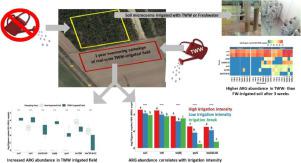Water Research ( IF 11.4 ) Pub Date : 2021-01-08 , DOI: 10.1016/j.watres.2021.116818 Ioannis D. Kampouris , Shelesh Agrawal , Laura Orschler , Damiano Cacace , Steffen Kunze , Thomas U. Berendonk , Uli Klümper

|
Treated wastewater (TWW) irrigation is a useful counter-measure against the depletion of freshwater (FW) resources. However, TWW contains several contaminants of emerging concern, such as antibiotic resistant bacteria (ARB) and antibiotic resistant genes (ARGs). Thus, TWW irrigation might promote the spread of antimicrobial resistance in soil environments. In the present work, we hypothesized that the ARG load and irrigation intensity define the effect of TWW irrigation on ARG spread dynamics in soil. This hypothesis was tested using a multiphase approach: a) comparing soil from a full-scale, commercially operated, TWW irrigated field with non-irrigated soil, b) long-term sampling of the TWW irrigated field over one year with different irrigation intensities and intercepted by irrigation breaks and c) laboratory-scale soil microcosms irrigated with TWW compared to FW. Six ARGs, the integrase gene intI1 and the 16S rRNA were quantified using qPCR. In addition, effects of TWW irrigation on bacterial community composition of microcosm-samples were analysed with 16S rRNA amplicon sequencing. The genes sul1, qnrS, blaOXA-58, tet(M) and intI1 were significantly more abundant in the TWW irrigated field soil, whereas blaCTX−-M-32 and blaTEM, the least abundant genes in the TWW irrigation, showed higher abundance in the non-irrigated soil. The relative abundance of sul1, qnrS, blaOXA-58, tet(M) and intI1 correlated with TWW irrigation intensity and decreased during irrigation breaks. Despite the decrease, the levels of these genes remained consistently higher than the non-irrigated soil indicating persistence upon their introduction into the soil. Microcosm experiments verified observations from the field study: TWW irrigation promoted the spread of ARGs and intI1 into soil at far elevated levels compared to FW irrigation. However, the impact of TWW irrigation on 16S rRNA absolute abundance and the soil microbial community composition was negligible. In conclusion, the impact of TWW irrigation depends mainly on the introduced ARG load and the irrigation intensity.
中文翻译:

抗生素抗性基因的负载量和灌溉强度决定了废水灌溉对土壤微生物组中抗生素抗性的影响
经处理的废水(TWW)灌溉是针对淡水(FW)资源枯竭的有用对策。但是,TWW包含一些令人关注的污染物,例如抗生素抗性细菌(ARB)和抗生素抗性基因(ARG)。因此,TWW灌溉可能会促进土壤环境中抗菌素耐药性的传播。在目前的工作中,我们假设ARG负荷和灌溉强度确定了TWW灌溉对ARG在土壤中传播动力学的影响。使用多阶段方法对这一假设进行了测试:a)将全尺寸,商业运营的TWW灌溉场的土壤与非灌溉土壤进行比较,b)用不同的灌溉强度对TWW灌溉地进行为期一年的长期采样,并被灌溉间隔中断; c)与FW相比,用TWW灌溉的实验室规模土壤微观世界。六个ARG,整合酶基因使用qPCR定量intI1和16S rRNA。此外,用16S rRNA扩增子测序分析了TWW灌溉对微观样本细菌群落组成的影响。基因sul1,qnrS,BLA OXA-58 ,TET(M)和intI1被显著更丰富的TWW灌溉田土壤,而血乳酸CTX - - M-32和BLA TEM,所述至少丰富的基因在TWW灌溉,显示非灌溉土壤的丰度更高。sul1,qnrS,bla OXA-58 ,tet(M)和intI1的相对丰度与TWW灌溉强度相关,在灌溉中断期间降低。尽管减少了,但这些基因的水平始终高于未灌溉的土壤,表明它们在引入土壤后仍具有持久性。缩影实验证实了来自实地研究的观察结果:与FW灌溉相比,TWW灌溉以极高的水平促进了ARGs和intI1在土壤中的扩散。但是,TWW灌溉对16S rRNA绝对丰度和土壤微生物群落组成的影响可以忽略不计。总之,TWW灌溉的影响主要取决于引入的ARG负荷和灌溉强度。










































 京公网安备 11010802027423号
京公网安备 11010802027423号